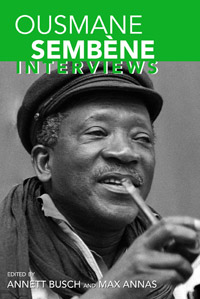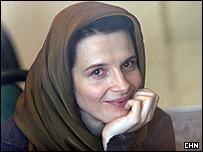OUSMANE SEMBÈNE: INTERVIEWS, Edited by Annett Busch and Max Anas, Jackson: University Press of Mississippi, 2008, 225 pp.

What an absurdly arduous and uphill battle it’s been, to understand even the rudiments of African cinema! I now have three books about the father of African cinema, but it hasn’t been until I started looking at the third that I began to pick up some fundamental, basic data. I’m thinking in particular of Sembène’s first feature, La noire de… (1966), known inadequately in English as Black Girl, only 65 minutes long. Yesterday, on one of my periodic trips back to the Chicago Reader to collect mail that still erroneously or fortuitously gets sent to me there, I was delighted to find a copy of this new volume, the latest in an excellent series of interview collections, unwrapped in my mailbox.
In 1995, I devoted a long review in the Reader to Black Girl, Sembène’s remarkable adaptation of his own story, “Promised Land” (which can be found in his collection Tribal Scars). By the time I reprinted this in my 1997 Movies as Politics, I was able to add a footnote correcting a false supposition I’d made about a color sequence that was in some prints of the film, but not in any I’d seen, after a friend who’d seen this sequence wrote me about it. Read more

BLAST OF SILENCE, written, directed by & starring Allen Baron, narrated by Lionel Stander (Criterion DVD).
An interesting period piece (1961), especially striking for its sense of place (Manhattan during the Christmas season), though I can’t accept this as the noir masterpiece some people are calling it–not when a recycling of generic clichés usually has to take the place of observation. Perhaps the most durable of its standbys is the gravelly voiceover of an uncredited, graylisted Lionel Stander (put to still better use in some of the Ben Hecht features), reciting the freewheeling patter of a pseudonymous, blacklisted Waldo Salt. It was clever of Baron to graft this pair over his own lackluster inventions, even if Salt’s pseudopoetry is sometimes almost as pretentious as the kind heard in Gary Merrill’s voiceover in another documentary-style indy, THE SAVAGE EYE, made the previous year. But I could probably listen to Stander reading from the Manhattan phone directory–-though there may be moments here when a few choice New York phone numbers might have enlivened Salt’s prose a little. Even so, none of it is nearly as awful as the interminable singing of a Village Gate conga-drum player named Mel Sponder, which Baron presumably indulges in in the interests of “atmosphere”. Read more
Sorry that the links for this no longer work. — J.R.

As far as I know, the above photograph of Juliette Binoche in Iran doesn’t come from Shirin, the latest feature by Abbas Kiarostami, which just premiered in Venice. And I’m certain that the two photographs of Binoche below, which I’ve found elsewhere on the Internet, doesn’t come from this film, even though Binoche’s trip to Iran was at Kiarostami’s invitation, and she’s generally credited as the “star” of his new film. For one thing, most accounts seem to agree that Binoche doesn’t wear any makeup in Shirin, and she appears to be doing just that in all three of these photographs.
Judging by some early reviews of Shirin–the best of which is probably Ronnie Scheib’s in Variety, and several of which are usefully grouped together by David Hudson in GreenCine Daily–it’s a development and expansion of “Where is My Romeo?”, Kiarostami’s segment in last year’s Chacun Son Cinéma, in which a wide assortment of females are seen responding to an unseen and possibly imaginary film of Romeo and Juliet. And there’s reason to believe that the unseen film apparently being responded to by Binoche and a good many Iranian actresses in Shirin–apparently an adaptation Farrideh Golbou’s poem “Khosrow e Shirin” by Mohammad Rahmanian, with a very elaborate soundtrack–is imaginary as well. Read more



